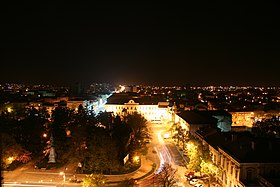Brăila
| Brăila | |
|---|---|
      
From left: Overview of the city (night view), Maria Filotti Theatre, Hotel Danubiu, Old town, Lyra Palace, Saint Nicholas Church, Headquarters of the Naval Authority, Traian statue.
|
|
 Location of Brăila |
|
| Coordinates: 45°16′09.1″N 27°57′26.9″E / 45.269194°N 27.957472°ECoordinates: 45°16′09.1″N 27°57′26.9″E / 45.269194°N 27.957472°E | |
| Country |
|
| County | Brăila County |
| Status | County capital |
| Government | |
| • Mayor | Marian Dragomir (Social Democratic Party) |
| Area | |
| • Total | 77.9 km2 (30.1 sq mi) |
| Elevation | 25 m (82 ft) |
| Population (2011 census) | |
| • Total | 180,302 |
| • Density | 2,314/km2 (5,990/sq mi) |
| Time zone | EET (UTC+2) |
| • Summer (DST) | EEST (UTC+3) |
| Postal code | 810xxx |
| Area code(s) | (+40) 239 |
| Vehicle registration | BR |
| Website | www |
Brăila (Romanian pronunciation: [brəˈila]; Greek: Βράιλα; Turkish: İbrail) is a city in Muntenia, eastern Romania, a port on the Danube and the capital of Brăila County. It is located in the close vicinity of Galați. The Sud-Est Regional Development Agency is located in Brăila.
According to the 2011 Romanian census there were 180,302 people living within the city of Brăila, making it the 11th most populous city in Romania.
Before 14th century, a small village existed in the place of today's Brăila, probably inhabited by fishermen and small merchants. The village fell to the Mongols during the 1241 Mongol invasion of Europe and it was under direct control of the rulers of Argeș in mid-14th century.
A settlement called Drinago was found in several 14th century Catalan and Spanish portolan charts (Angelino de Dalorto, 1325/1330 and Angelino Dulcert, 1339), as well as in the Book of Knowledge of All Kingdoms. This may have been an erroneous transcription of Brillago, a name which was later used in 15th century traveller's journals.
In Greek documents of roughly that time, the city is referred to as Proilabum or Proilava, a Greek language adaptation of its Slavic name, Brailov. In German language sources, it is mentioned as Uebereyl. The origin and meaning of the name is unknown, but it is thought to be an anthroponym.
...
Wikipedia

